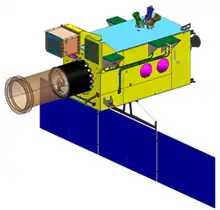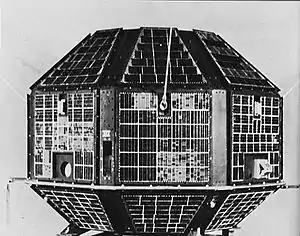 GISAT-1 spacecraft in the cleanroom before encapsulation. | |
| Manufacturer | |
|---|---|
| Country of origin | India |
| Operator | ISRO |
| Applications | Earth observation |
| Specifications | |
| Bus | I-2K [1] |
| Launch mass | 2268 kg [2][3] |
| Power | 2280 watts[1] |
| Equipment | Ritchey-Chrétien telescope[4] Multispectral array detectors Steerable antenna |
| Regime | Geostationary orbit |
| Design life | 7 years (planned) |
| Dimensions | |
| Production | |
| Status | Planned |
| Launched | 1 |
| Operational | 0 |
| Failed | 1 |
| Lost | 0 |
| Maiden launch | 12 August 2021, 00:13 UTC[5][6][7][8] |
Geo Imaging Satellite or GISAT is an Indian imaging satellite class for geostationary orbit with a high temporal resolution, meant for providing near real time imaging with fast revisit capability and real time monitoring.[9] Two satellites will provide resolution in the range of 42 to 318 m.[1][10] It will carry multi-spectral (Visible and Near-InfraRed, and Short Wave-InfraRed), multi-resolution (42 to 318 m) imaging instruments.[11]
The first satellite; EOS-3 (aka GISAT-1) was launched on 12 August 2021 but failed to reach orbit as cryogenic upper stage of GSLV could not ignite. EOS-3 was supposed to fulfil civilian applications.[12]
The second satellite, EOS-5 (aka GISAT-2) will be acquired by Indian Navy and will differ slightly in capabilities compared to EOS-03 (aka GISAT-1).[13][12][14]
Payload

GISATs will image in multi-spectral and hyper-spectral bands to provide near real-time pictures of large areas of the country, under cloud-free conditions, at frequent intervals which is, selected field image in every 5 minutes and entire Indian landmass image every 30 minutes at 42 m spatial resolution.[1]
Features of GISAT-1 are:
- 700 mm Ritchey–Chrétien telescope based on the design of Cartosat-2A
- Array detectors in Visible and Near-InfraRed (VNIR), and Short Wave-InfraRed (SWIR) bands
- Electronically steerable, phased array antenna
- High agility, jitter-free platform
| Band | Channels | Ground Resolution(m) | Range(μm) |
|---|---|---|---|
| Multispectral (VNIR) | 6 | 42 | 0.45 – 0.875 |
| Hyperspectral (VNIR) | 158 | 318 | 0.375 – 1.0 |
| Hyperspectral (SWIR) | 256 | 191 | 0.9 – 2.5 |
Launch schedule
| Designation | COSPAR ID | NORAD ID | Power | Launch | Orbital parameters | Remarks | ||||
|---|---|---|---|---|---|---|---|---|---|---|
| Launch date, Time (UTC) | Launch mass | Launch vehicle | Launch site | Orbit | Longitude | |||||
| EOS-03 (GISAT-1) |
Failed to orbit[15] | 2280 watts | 12 August 2021, 00:13 UTC |
2268 kg | GSLV-F10 | SDSC | GTO | 85.5° East (planned) | [16][17][18][19][20][21][3][22][23][8] | |
| EOS-05 (GISAT-2) |
TBD | TBD | 2280 watts | March 2024 (planned) | 2268 kg | GSLV-F14 | SDSC | GTO | [24][25][23][26] | |
See also
References
- 1 2 3 4 5 "GSLV F10/GISAT-1 Brochure". Retrieved 26 February 2020.
- ↑ "Annual Report 2015-2016". Indian Space Research Organisation. December 2015. p. 35. Archived from the original on 5 July 2016.
- 1 2 "GSLV Planned launch". VSSC. Retrieved 22 December 2019.
- ↑ "Gisat 1, 2 (Eos 03, 05)".
- ↑ "Launch of India's new-age Earth imaging satellite by May 15: K. Sivan". Retrieved 15 April 2021.
- ↑ "ISRO revises launch schedule of GISAT-1 after "minor issue" with satellite". Retrieved 26 March 2021.
- ↑ Chethan Kumar (9 April 2021). "Voltage issue further delays launch of Gisat-1". The Times of India. Retrieved 9 April 2021.
- 1 2 "ISRO plans to launch geo imaging satellite on August 12". The Hindu. PTI. 10 July 2021. ISSN 0971-751X. Retrieved 10 July 2021.
{{cite news}}: CS1 maint: others (link) - ↑ https://www.isro.gov.in/sites/default/files/flipping_book/annual_report_2019-20_english/files/assets/common/downloads/Annual%20Report%202019-20%20
- ↑ Srivastava, Alok (3 January 2016). "User Interface Meet 2016: "New Indian eye in GEO"". nrsc.gov.in. Archived (PDF) from the original on 30 August 2016. Retrieved 7 March 2021.
- ↑ "Untitled Page".
- 1 2 K, Chethan (7 May 2022). "Navy to acquire Gisat-2; Dedicated satellite to boost capability in IOR region | India News - Times of India". The Times of India. Retrieved 7 May 2022.
The first one (Gisat-1) was for civilian use, but Gisat-2 is for strategic purposes and the navy has very specific requirements which they (Isro) need to meet,
- ↑ "Ministry of Defence, Demands for Grants (2022-23), Army, Navy, Air Force, Joint Staff, Military Engineer Services, Servicemen Contributory Health Scheme And Sainik Schools (Demand No. 20 and 21)" (PDF). March 2022. Archived (PDF) from the original on 19 March 2022.
- ↑ "Space research in India, January 2018 – June 2020" (PDF). Archived from the original (PDF) on 4 March 2021.
GISAT Series: Geo Imaging Satellite is envisaged to provide high resolution imaging capability from geostationary orbit. It will consist of high-resolution imaging in VNIR (GISAT-1/-2) and LWIR (GISAT-2). There will be two hyperspectral imagers covering VNIR and SWIR regions. GISAT-1 payload was successfully delivered to the project.
- ↑ "যান্ত্রিক ত্রুটি, পুরোপুরি সফল হল না উপগ্রহ 'GISAT-1'-এর উৎক্ষেপণ" (in Bengali). Zee News. Zee News. 12 August 2021. Retrieved 12 August 2021.
- ↑ "অতিমারির অন্ধকার ফুঁড়ে ফের উৎক্ষেপণে নামছে ইসরো, বৃহস্পতিবার কক্ষপথে যাবে জিস্যাট-১" (in Bengali). Kolkata: anandabazar.com. Anandabazar. 10 August 2021. Retrieved 12 August 2021.
- ↑ "भारत का सबसे ताकतवर टेलीस्कोप, अब PAK पर हर पल नजर" (in Hindi). Aaj Tak. 20 December 2019. Retrieved 20 December 2019.
- ↑ "દર 30 મીનિટે આકાશમાંથી ભારતને મળશે એક તસવીર, ઈસરો રચવા જઈ રહ્યું છે નવો ઇતિહાસ" (in Gujarati). GSTV. 21 December 2019. Retrieved 22 December 2019.
- ↑ "ఫిబ్రవరిలో జీఎస్ఎల్వీ ప్రయోగం". eenadu.net (in Telugu). EENADU. Retrieved 27 January 2020.
- ↑ "इसरो जाकर सैटेलाइट लांचिग देखेंगी रांची की मृदुला". jagran.com (in Hindi). Retrieved 14 February 2020.
- ↑ "Status report on the current and future satellite systems by ISRO". Retrieved 21 September 2019.
- ↑ "The launch of GISAT-1 onboard GSLV-F10, planned for 5 March 2020, is postponed". isro.gov.in. ISRO. Archived from the original on 16 July 2021. Retrieved 4 March 2020.
- 1 2 "ANNUAL REPORT 2020-2021" (PDF). ISRO. Archived from the original (PDF) on 25 April 2021. Retrieved 6 March 2021.
- ↑ "GSLV Project: Planned launches of GSLV". Retrieved 22 December 2019.
- ↑ "HAL hands over 50th set of L-40 stage of GSLV-MKII to ISRO". zeenews.india.com. 28 February 2020. Retrieved 28 February 2020.
- ↑ "ISRO report on highlights and issues in dataset and product generation". April 2023.
GISAT-2 is scheduled for launch in March 2024.
